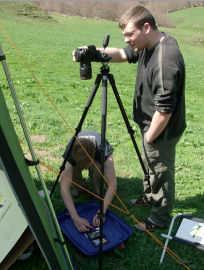VIVA success for James Burgon
Published: 4 April 2018
We are pleased to announce that James Burgon successfully defended his PhD thesis on the 19th March
 We are pleased to announce that James Burgon successfully defended his PhD thesis on the 19th March. James has been working with Dr Dr Kathryn Elmer and Professor Barbara Mable since he joined the Institute of Biodiversity, Animal Health and Comparative Medicine in 2013. Dr Ross MacLeod convened the VIVA with Dr Roman Beik (IBAHCM) and Dr Martin Taylor (University of East Anglia) examining his thesis “Evolutionary and genomic associations of colour and pattern in fire and Alpine salamanders (Salamandra spp.)”. Here James gives us a short summary of the key findings from his research.
We are pleased to announce that James Burgon successfully defended his PhD thesis on the 19th March. James has been working with Dr Dr Kathryn Elmer and Professor Barbara Mable since he joined the Institute of Biodiversity, Animal Health and Comparative Medicine in 2013. Dr Ross MacLeod convened the VIVA with Dr Roman Beik (IBAHCM) and Dr Martin Taylor (University of East Anglia) examining his thesis “Evolutionary and genomic associations of colour and pattern in fire and Alpine salamanders (Salamandra spp.)”. Here James gives us a short summary of the key findings from his research.
The natural world is filled with striking and complex colour patterns. In animals, these tend to be associated with ecologically adaptive traits known to drive biological diversification, for example predator avoidance and physiological regulation. This means that animal colouration is conspicuously affected by natural selection, making it an ideal system in which to study the evolutionary processes that generate and maintain biological diversity. For the last four years I have immersed myself in this colourful line of research, with a specific focus on the molecular basis of colouration in a charismatic genus of amphibians called Salamandra.
Commonly known as the fire and Alpine salamanders, Salamandra species typically present bright, highly variable yellow-black patterns consisting of spots and/or stripes, which are thought to hold an aposematic (warning) function related to their toxic secretions. In addition to this, individual species and populations have evolved melanic (black), fully yellow and fully brown colourations, with gradations seen in-between. Unfortunately, the evolutionary relationships between Salamandra species have been difficult to resolve, and the molecular basis of amphibian colouration is poorly understood in comparison to other vertebrate groups like mammals, birds and fish. That is, until now.
Using a number of next-generation sequencing techniques, my collaborators and I conducted the most in-depth phylogenomic analysis of the genus Salamandra to date, from which we were able to robustly resolve the evolutionary relationships between Salamandra species (a study we published in the journal Molecular Phylogenetics and Evolution). Following this, I extended the analysis in order to resolve the evolutionary relationships between Salamandra subspecies and identify cases of parallel colour pattern evolution, finding that both melanic and striped patterns have arisen independently more than once across the genus.
 Finally, I focused in on a highly colour variable population in northern Spain to identify genetic associations with colour and pattern. By combining quantitative colour pattern analyses and next-generation sequencing techniques, I was able to identify 43 genomic loci (genetic markers) and 196 differentially expressed genes associated with colouration in the group.
Finally, I focused in on a highly colour variable population in northern Spain to identify genetic associations with colour and pattern. By combining quantitative colour pattern analyses and next-generation sequencing techniques, I was able to identify 43 genomic loci (genetic markers) and 196 differentially expressed genes associated with colouration in the group.
This research marks a substantial contribution to our understanding of amphibian colour genetics and provides a rich resource for future evolutionary studies. By combining the phylogenetic and colour genetic aspects of this study we can now look at the parallel evolution of colour phenotypes within Salamandra. Further, we can expand this work to look at the convergent evolution of similar colour patterns in distantly related vertebrates. Such studies will allow us to assess the repeatability and predictability of, as well as the constraints on, vertebrate colour pattern evolution by natural selection.
Congratulation to Dr James Burgon. James has recently joined the BES Scottish Policy Group committee and is currently working with the Edinburgh International Science Festival. We wish James all the best with plans to pursue a career in science policy and science communication.
First published: 4 April 2018

